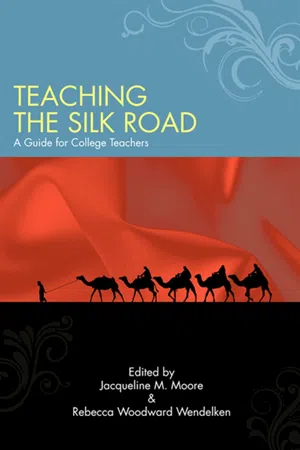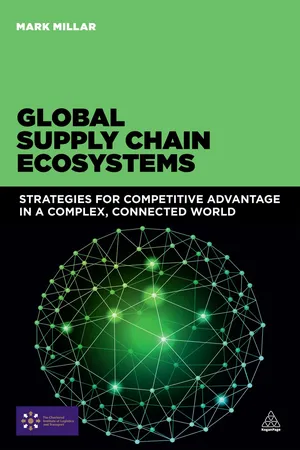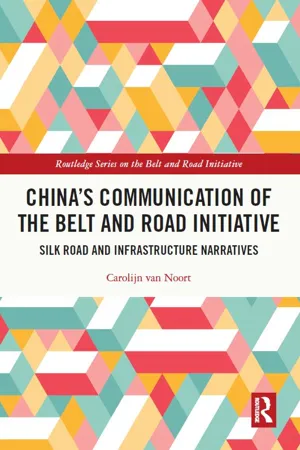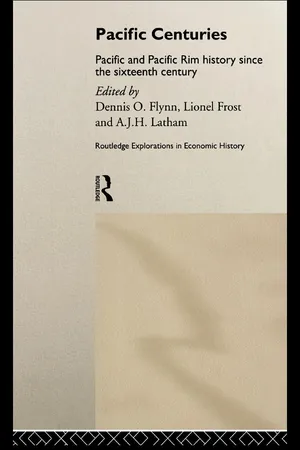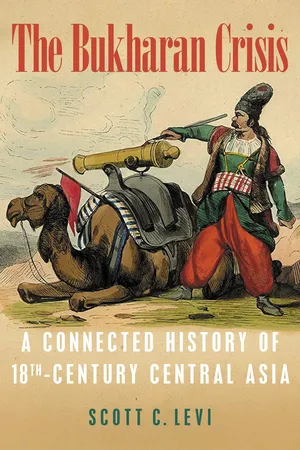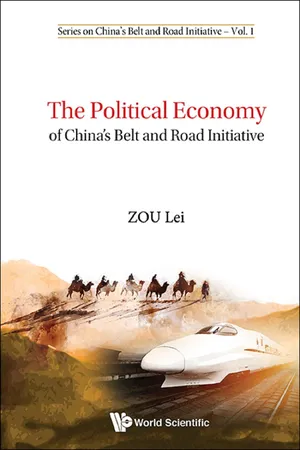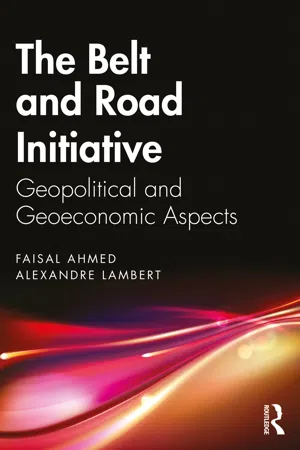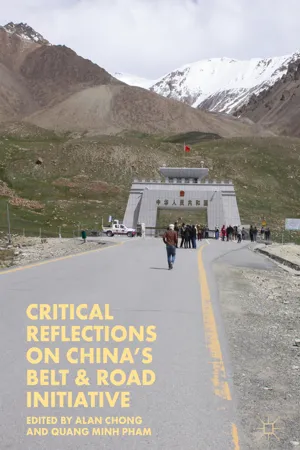History
The Silk Roads
"The Silk Roads" refers to the ancient network of trade routes that connected the East and West, facilitating the exchange of goods, ideas, and cultures between different civilizations. This network played a crucial role in shaping the development of societies and economies across Asia, Europe, and Africa. The Silk Roads were instrumental in the spread of technologies, religions, and philosophies, contributing to the interconnectedness of the ancient world.
Written by Perlego with AI-assistance
Related key terms
Related key terms
1 of 4
Related key terms
1 of 3
11 Key excerpts on "The Silk Roads"
- eBook - ePub
The Belt and Road Initiative
A Pathway towards Inclusive Globalization
- Liu Weidong(Author)
- 2019(Publication Date)
- Routledge(Publisher)
The Silk Road refers to the general term for long-distance commercial trade and cultural exchange routes gradually developed from ancient times, stretching through Eurasia and even reaching northern and eastern Africa. The Silk Road is a product generated from the interaction of material and spiritual culture between ancient China and other countries and nations, the result of collisions of Eastern and Western civilizations, and also an embodiment of the Chinese nation’s pioneering spirit in history. The Silk Road, from the perspective of history, connecting Eastern and Western cultures, enriched people’s material life of those ethnic groups and countries along the Road and facilitated the civilization process of the world. It was, looking back to the history of more than 2,000 years, not some fixed trade route but a bridge for communication between the West and the East. The specific routes of the Silk Road constantly changed as geographical conditions changed and the political and religious situation evolved. The opening and the prosperity of the Silk Road have promoted the socioeconomic development of a large part of the world’s most densely populated area in terms of politics, economy and culture. And the history of the Silk Road is the history of goods exchange, trade intercourse, and cultural interactions among the countries, ethnic groups, and various regions along the Road, which benefit greatly from such exchanges.The Silk Road has profound economic and cultural foundations, and is the result of the highly developed human civilization. The great economic and cultural development of these countries and ethnic groups along the Road laid the foundation for the Road. Without the emergence and development of the Eastern and Western civilizations along the Road, there would be no Silk Road. The great development of economy and culture in countries along the Road created great material foundations for the emergence and opening of the Silk Road, while the differences in natural endowments and economy generated a strong desire and demand for material and cultural exchanges among people in those regions. - Victor Chan, Yew-Foong Hui, Desmond Hui, Kazem Vafadari(Authors)
- 2023(Publication Date)
- Routledge(Publisher)
2019 ).The coining of the term has been attributed to Ferdinand von Richthofen, a German geologist and baron, who, on returning from a surveying trip to China in the early 1870s, referred to a Silk Road (Seidenstraße) to describe particular routes of trade from China to Central Asia during the Han Empire (206 BCE–220 CE).2 It is critically important to recognise, however, that Richthofen captured only a tiny fragment of a much larger history of pre-modern trade, exchange and regional empires, a history that we are still to fully comprehend. (Frank, 1998 ; Waugh, 2007 )The two decades leading up to the First World War are often referred to as the ‘golden age’ of Silk Road scholarship (see, for example, Whitfield, 2008 ; Wood, 2002 ). Researchers and explorers from Britain, France, Germany, Japan, Russia and Sweden travelled to Central Asia as part of the ‘Great Game’ in search of manuscripts, artefacts and artworks (see Figure 2.2 ). At that time, the region was a remote outpost in the geographies of European empire, and the discoveries of these men built on Richthofen’s account of a pre-modern world of cultural flows and trade routes. The pinnacle of this brief, but golden, era of archaeology and philology remains the visit by Aurel Stein to a network of grottoes a few miles outside Dunhuang in China in 1907. At its height, Dunhuang was the crossroads of two principal trade routes bordering the Taklamakan Desert and served as an important stop on the north-south road connecting Mongolia with Tibet (Jacobs, 2012, 2020 ). An estimated 45,000 murals were painted across 500 or so grottoes. Stein’s visit cemented the idea of Central Asia as an important centre of civilisational exchange and cultural production. He was particularly interested in the historical connections with India, but further interpretations of his finds by scholars back in Europe used the writings of Marco Polo and Ptolemy to evidence long-distance trade histories stretching from the Mediterranean to East Asia.3- eBook - ePub
Teaching the Silk Road
A Guide for College Teachers
- Jacqueline M. Moore, Rebecca Woodward Wendelken, Jacqueline M. Moore, Rebecca Woodward Wendelken(Authors)
- 2012(Publication Date)
- SUNY Press(Publisher)
2 Indeed, European history instructors often examine how Europe affected the rest of the world as a matter of course. But further study of The Silk Roads highlights how these interregional connections shaped the course of events within Europe as well. For example, examining how The Silk Roads linked Europe to the Eurasian economy for centuries contextualizes the confrontation between the Ottoman empire and European states.Organizing a history survey around a conceptual narrative that recognizes the underlying unity of the Afro-Eurasian world in the prein-dustrial era allows for a more sophisticated analysis of change over time in European history. For example, David Christian suggests that the study of “trans-ecological exchanges” along The Silk Roads offers a valuable alternative to the more traditional “trans-civilizational exchanges,” since it incorporates an appreciation of the role of environment and geography in human affairs.3 Outsiders’ views of European customs (and European travelers’ notes on what they found remarkable in other cultures) can help students recognize not only what was distinctive about European culture historically, but also what linked Europe to the larger world before the sixteenth century. Hence, The Silk Roads is not merely yet another topic to try to stuff into a European history survey, but rather is of fundamental importance for understanding the European past.This chapter examines how the themes of the conventional European history survey can be adapted to incorporate material from The Silk Roads. During the classical era, the Greeks and Romans built empires that brought them into contact with The Silk Roads. Products from Asia became very desirable commodities. In the Byzantine and Medieval eras, despite conflicts with the Islamic world, Italian merchants continued to carry luxuries from The Silk Roads to the West. By the time of the Renaissance, Europe’s desire to emulate the splendor of the East inspired a number of technological and commercial innovations. Even during the development of nineteenth-century imperialism, excavation of the art treasures of The Silk Roads became another theater in which to act out imperial rivalries. The topics and readings suggested here can enliven discussions and enhance learning opportunities in European History courses. - eBook - ePub
Global Supply Chain Ecosystems
Strategies for Competitive Advantage in a Complex, Connected World
- Mark Millar(Author)
- 2015(Publication Date)
- Kogan Page(Publisher)
07 The New Silk Road connecting Europe and AsiaAn historic trade route revived for the 21st century
For more than two millennia the Silk Road has provided a trade route between China in the Far East through the Middle East to Europe, starting from Xi’an (formerly Chang’an) in central China and reaching all the way into the Mediterranean. Trade along this ancient route began in the third century and over the years has extended beyond just the transportation of goods, also providing a means for the exchange of ideas and culture between China, India, Persia, Arabia, Greece and Rome. The Silk Road reached peak activity in the 13th and 14th centuries, after which trade gradually declined as the Mongol and Byzantine empires faded and the powers along the route became more separated culturally and economically. The name ‘Silk Road’ itself does not originate from the Romans but is a 19th century term, coined by the German scholar, Ferdinand von Richthofen.Historically, the term Silk Road meant a network of different routes which, while all running generally from east to west and vice versa, were in reality a network of roads connecting trade centres across the entire continent. The northern route ran from Shangdu across the grasslands and north of the Caspian and Black Seas into central Europe; the main central route ran from south of Beijing through Xi’an and Samarkand into Damascus; a shorter journey linked Chendgu with India, and the marine Silk Road followed the same routes as today from the east coast of China south through the straits of Malacca to Egypt.Explorer Marco Polo travelled the Silk Road to reach China and in his writings described in detail Chinese politics, economy and culture. His exploits generated considerable interest in the region from the courts of Europe and had a powerful effect on the growth of European navigation. - eBook - ePub
China's Communication of the Belt and Road Initiative
Silk Road and Infrastructure Narratives
- Carolijn van Noort(Author)
- 2021(Publication Date)
- Routledge(Publisher)
Frankopan 2015 , 518). This then demands a closer examination of China's communication of the Silk Road, and its history more broadly.The term the Silk Road (Seidenstrasse) was originally coined by the German geographer Ferdinand von Richthofen in the late 19th century (Richthofen 1877 ), and “refers to multiple networks flourishing from around 100 BCE to the 15th century, when traders from cultures now recognized as ’East’ and ’West’ traveled extensively on land and sea across the Asian continent, exchanging silk and many other goods and ideas” (Thorsten 2005 , 301). Richthofen mainly focused on the Silk Routes of the Han dynasty (Winter 2019 , 42), but the spatial and temporal understanding of the Silk Road has significantly expanded in contemporary thought. There was not one fixed road between the Chinese city of Xi’an and Rome; instead, there were many different roads that changed course over time and in traffic intensity. While there were many Silk Roads (plural) and not just one, this book uses the singular form to refer to its history for conciseness.China revives the Silk Road with the objective to associate its infrastructure vision and action plans with a legacy of peace, trade, prosperity, and connectivity (van Noort 2019 ). China's President Xi Jinping explained in one of his speeches that the “2,000-plus-year history of exchanges had proved that countries with differences in race, belief and cultural background can absolutely share peace and development as long as they persist in unity and mutual trust, equality and mutual benefit, mutual tolerance and learning from each other, as well as cooperation and win-win outcomes” (Ministry of Foreign Affairs of the People's Republic of China 2013 ). China promotes the revival of a so-called “Silk Road spirit” (Ministry of Commerce of the People's Republic of China 2019 ; Ministry of Foreign Affairs of the People's Republic of China 2019 - eBook - ePub
- Dennis O. Flynn, Lionel Frost, A.J.H. Latham, Dennis O. Flynn, Lionel Frost, A. J. H. Latham(Authors)
- 1998(Publication Date)
- Routledge(Publisher)
(die Seidenstrasse) was coined by the nineteenth-century German explorer Baron Ferdinand von Richthofen. Although silk was perhaps the most important commodity that traveled along the Road, others such as precious metals and stones, spices, porcelain and textiles also passed through. However, the Silk Road was perhaps more significantly an avenue for the exchange of ideas. Some of the most fundamental ideas and technologies in the world—methods of making paper, printing, and manufacturing gunpowder, among many others—made their way across Asia via this highway. Migrants, merchants, explorers, pilgrims, refugees, and soldiers brought along with them religious and cultural ideas, domesticated animals, plants, flowers, vegetables, fruit, plagues and disease, as they joined this gigantic cross-continental exchange. The Silk Road, as so rightfully claimed, was the melting pot, the lifeline of the Eurasian Continent (Franck and Brownstone 1986:2; Werblowsky 1988). In East Asia, the Silk Road has long been enshrined as a symbol of cross-cultural exchanges of religions, commodities and technology.This chapter, motivated by the concept of the Silk Road as an avenue of exchange of goods and ideas, concerns the history of global trade and technological diffusion. The trading history of silk presents a classic case for studying the incremental and cumulative nature of growth of trade and the stock of knowledge made possible by the increasing human interactions and improved means of transportation. The chapter is divided into three parts: the first brings together a brief narrative of the long history of the silk trade and the technological diffusion on the overland route. The second focuses on the sea route and the third presents a discussion of the interactions among trade, technological and institutional progress and the transportation systems on the overland and sea routes.Silk Road: the overland system
The Road: its beginning and consolidation
Sericulture and silk weaving had been established in the Yellow River and Yangtze River areas of China thousands of years before Christ. Production of silk started in China between perhaps 5000 and 3000 BC (Fan and Wen 1993:2). This great Chinese invention began with the ingenious discovery of reeling silk threads off wild silkworm cocoons, followed by the conscious domestication of silkworms. The making of silk could be roughly divided into three main stages. Sericulture denotes the process of planting mulberry trees, feeding silkworms, and subsequently collecting cocoons spun by the silkworms. Then, from these cocoons, farmers could reel off long and continuous threads and wind them onto bobbins to form the so-called raw silk. Finally, raw silk (sometimes after an additional process of twisting or “throwing”) was left to silk weavers (or knitters) to turn into silk cloth.1 - eBook - ePub
Central Eurasia in Context
A Connected History of 18th Century Central Asia
- Scott C. Levi, Scott Levi(Authors)
- 2020(Publication Date)
- University of Pittsburgh Press(Publisher)
TWO
SILK ROADS, REAL AND IMAGINED
Scholars have studied the cultural exchanges that unfolded along the network of Central Asian routes of commerce and communication popularly known as the Silk Road for well over a century, since even before Sir Aurel Stein, Sven Hedin, Paul Pelliot, and other scholar-adventurers first led expeditions into Xinjiang (Altishahr to the local population).1 Their collective work has done much to illuminate the trans-Eurasian transmission of scientific knowledge and technologies, religions, languages and literary traditions, artistic motifs, fine silks and other merchandise, and much more. At the same time, considerably less attention has been directed to the Silk Road traders themselves, the actual individuals and merchant groups whose labors are credited (often mistakenly so) for having propelled these cultural exchanges.The primary objective of this chapter is to identify a number of false assumptions long embedded within the Silk Road paradigm. Paramount among these is the notion that Central Asia’s economic prosperity rested wholly upon the region’s ability to mediate China’s westward trade. Although the concept of the Silk Road was derived in the West, its history is most often presented from the Chinese perspective, with Central Asian traders playing the role of cultural intermediaries and functioning as subsidiary agents and middlemen cargo carriers whose principal economic activity involved moving Chinese goods to the Mediterranean and, to a lesser extent, linking the latitudinal caravan routes with India. Too often, scholars working in various subfields of what might be termed “Silk Road Studies” have uncritically accepted and propagated this perspective, and in a number of important ways this has resulted in a Sinocentric distortion of Central Asian history. - Lei Zou, Zhiping Zhang(Authors)
- 2018(Publication Date)
- WSPC(Publisher)
C h a p t e r1
Reflections on the Ancient Silk Road
As the most important political, economic, cultural and religious link connecting Europe and Asia before the rise of the modern Western world, the Silk Road has become a key concept for describing the continuous communication between the East and West in the ancient times. Since the 20th century, various economic cooperation projects either within Asia or between the two continents have been carried out in the name of a “New Silk Road”. The Belt and Road Initiative is another large-scale cooperative initiative that adopts the historical symbol of the Silk Road.From the perspectives of geography, trade and religion, this chapter aims at portraying a historical horizon for understanding the Belt and Road Initiative in the new period, in view of the reflection over the rise and fall of the ancient Silk Road. Firstly, the evolution of the Silk Road — how did it connect ancient China with Eurasian countries via land and sea-is explored, and further, roots of the historic shift in prosperity from overland Silk Road to maritime Silk Road since the mid-to-late period of Tang Dynasty are investigated. Secondly, international trade on the ancient Silk Road is discussed from the perspectives of commodity and currency, which provides a historical coordinate for understanding the trade and economic cooperation on the modern Silk Road and the “Belt and Road” between China and the Middle Eastern countries. Thirdly, the historical course of Islamization of the ancient Silk Road is reviewed; on the basis of this, complicated interactions between the religious and political landscapes that may emerge on the modern Silk Road are discussed.1.1Land–Sea Relations
The ancient Silk Road, consisting of multiple trade routes, connected Asia, Europe and Africa through ocean and land. In different historical periods, the land and maritime trade routes have witnessed their own ups and downs.- eBook - ePub
The Belt and Road Initiative
Geopolitical and Geoeconomic Aspects
- Faisal Ahmed, Alexandre Lambert(Authors)
- 2021(Publication Date)
- Routledge India(Publisher)
2 Today, with the launch of the New Silk Roads or Routes (NSRs), and with the more official term of the Belt and Road Initiative (BRI), China effectively builds on its 5,000 years of civilisational heritage as well as economic and cultural leadership. With regard to the ASRs heritage, in particular, this means that UNESCO would label it as a world heritage of “exceptional universal value”:The (Ancient) Silk Roads were an interconnected web of routes linking the ancient societies of Asia, the (Indian) Subcontinent, Central Asia, Western Asia and the Near East, and contributed to the development of many of the world’s great civilizations. They represent one of the world’s preeminent long-distance communication networks stretching as the crow flies to around 7,500 km but extending to in excess of 35,000 km along specific routes. While some of these routes had been in use for millennia, by the 2nd century BC the volume of exchange had increased substantially, as had the long-distance trade between east and west in high value goods, and the political, social and cultural impacts of these movements had far-reaching consequences upon all the societies that encountered them.3Well before the official launch of the ASRs by the Chinese Han Dynasty during the 2nd century BC, connectivity infrastructure was developed at the heart of Eurasia. Even by the time of the ancient civilisations of Mesopotamia, Elam, and Assyria in contemporary Iraq, Iran, and Syria, and the corresponding dawn of the first historical scripts, major rulers, such as Babylonian Hammurabi, would be world renowned. They would be known not only as “law-givers” (as the term “Hammurabi” states) but also as promoters of large-scale infrastructure development. Together with the harmonisation of norms, standards, and regulations that were reflected with the famous “Hammurabi Code”, important investments in connectivity and logistics facilitated the integration of the Babylonian Empire.4 - eBook - ePub
Geocultural Power
China's Quest to Revive the Silk Roads for the Twenty-First Century
- Tim Winter(Author)
- 2019(Publication Date)
- University of Chicago Press(Publisher)
To generate an awareness of the different civilizations’ shared roots and to foster the concept of a plural world heritage that embraces the masterpieces of nature and culture in all countries is, in the final analysis, to encourage attitudes of openness and tolerance, so necessary in an essentially interdependent world. The fundamental issue at stake in the “roads of culture” approach is to highlight the significance of pluralism in culture, no less vital than that of biodiversity in nature. 123 More than twenty-five international conferences and colloquiums led to a series of publications that further diversified the geographies and themes of The Silk Roads. Once again, three routes—oasis, steppe, and sea—oriented the project. 124 But by drawing on new research, these events further expanded the framing by addressing the topics of nomadic culture, harbor cities, food, and Arab seafaring, as well as less familiar routes of connectivity, including the regional and long-distance connections of East Africa and Southeast Asia. 125 A decade of events and publications had a significant impact on raising the visibility of The Silk Roads across agencies engaged with international cultural policy, and, in so doing, gave attention to a geographically and thematically expansive definition of Eurasian connectivity. By the mid-1990s the idea of the Maritime Silk Road also began to gain visibility among cultural institutions in southern China. A collaboration between the Guangzhou Museum and Hong Kong’s Urban Council led to a large exhibition titled The Maritime Silk Route: 2000 Years of Trade on the South China Sea. 126 A few years later, the Smithsonian Institute in Washington, DC, took up the theme via The Silk Road: Connecting Cultures, Creating Trust festival. Located on the Washington Mall, their annual two-week festival has become a unique forum for cultural diplomacy - Alan Chong, Quang Minh Pham, Alan Chong, Quang Minh Pham(Authors)
- 2020(Publication Date)
- Palgrave Macmillan(Publisher)
93, 131). Pires did however distinguish the immense trading potential of Canton as a collection point of produce from all of China and of foreign merchants from the rest of Asia, from the stifling xenophobic authoritarianism of the Chinese emperor and his officials. If Canton represented in Portuguese eyes the unlimited wealth that could be traded out of China, the Portuguese would ultimately despatch Pires himself as their first ambassador to convince the Chinese to open up. As much as we can discern from Armando Cortesão’s thumbnail sketch of Pires’ life, Pires’ mission manifested ironically a clumsy combination of military prowess, piety and indulgence to the Chinese court, resulting unfortunately in the delegation’s dismal end (Cortesão 1944, pp. xxxvi–1). If there is a lesson to be learned from Pires’ demise, it is that his articulation of mercantile civilization was not universally shared even if he has left us with some measured observations about the ideal port city along the maritime Silk Road. Conclusion: A Silk Road Ecumenism? In this unusual reading of assorted ancient travelogues as political theory and political sociology, I have attempted to find some tentative answers to the question of how travellers on the ancient Silk Roads found answers to the eternal question of cohabiting with human differences in beliefs and customs. One clear answer is the idea of travelling the Road itself. Roads are both cultural and religious metaphors. Fa-Hsien, Marco Polo and Ibn Battuta travelled in search of inner need. For the Buddhist and Islamic pilgrims, the Road functioned as the vehicle and trial of their faith. The search for enlightenment meant overcoming or braving physical and other physiological dangers materializing unexpectedly on the road. A chance encounter with the right person could unlock a whole refreshing spring of spiritual affirmation. Friendship is spiritual. To be hospitable is to attain the highest of human values
Index pages curate the most relevant extracts from our library of academic textbooks. They’ve been created using an in-house natural language model (NLM), each adding context and meaning to key research topics.
Explore more topic indexes
Explore more topic indexes
1 of 6
Explore more topic indexes
1 of 4


